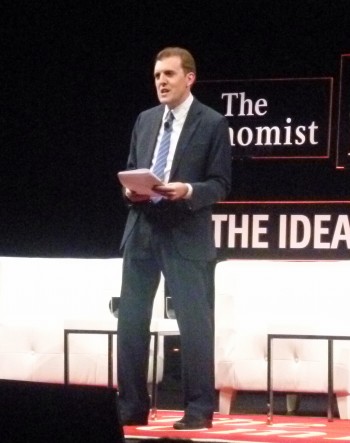Written by Luke Thompson.
Tom Standage, author and editor at one of the world’s most important newspapers, The Economist, talks about his Uni days, the future of digital journalism, Bill Gates and wearable technology. A lucky handful of the university’s journalism students benefited from a Q’&A’ master-class on Monday, January 27, with The Economist’s online Editor-in-Chief, Tom Standage.
A lucky handful of the university’s journalism students benefited from a Q’&A’ master-class on Monday, January 27, with The Economist’s online Editor-in-Chief, Tom Standage.
The select few booked their limited spots to hear Mr Standage share years of experience and give some essential advice in how to integrate into a new digital era of journalism.
Tom’s expertise in tech’ journalism started whilst studying Engineering and Computer Science at OxfordUniversity, whilst writing for the student newspaper – a period which he said mainly involved “playing the drums too much and not doing an awful lot of work.”
However, after a brief stint freelancing for The Guardian, Tom took on the permanent role of producing a successful internet supplement for The Daily Telegraph.
It was during this time, he told students, that he “very deliberately started writing in the style of The Economist”.
Not long after being taken on as science correspondent at his favourite publication, Tom found himself Digital Editor of the collective voice with the highest brow in current affairs.
Just as his own journey to the top was unintentional, speaking on the currently sustainable success The Economist are experiencing in remaining profitable in the transition from print to online platforms, Tom said that in a lot of areas, it was just that, “…Purely accidental.”
“Writing in English, but not being American is a huge advantage. Our global circulation is around 1.6 million now, with about 900,000 of that being in North America,” Tom said.
“There’s a group of people in America who want a global perspective that they don’t feel they get with their local media – TIME and Newsweek are essentially written by children.”
According to Tom there is a “massive gap in the market for an intelligent weekly newspaper for the world and The Economist is only publication which is really doing that.”
When asked by nervous newspaper-journalists-to-be in attendance if he thought print will eventually die out completely, the digitally savvy editor replied, “Yes, I think it will.”
He pointed out to students how many of the UK’s newspapers are becoming weeklies and that even the world’s biggest publications are subject to the same pressure: “The New York Times will be a weekly within five years time, I’m sure of it.”
Though Tom did note that news in print form may not become completely extinct and might take a niche turn for the enthusiasts.
“There maybe a market among our crazy readership for a $500 per year super-premium edition on really nice paper. Bill Gates is one our readers. He gets his copy hand delivered from our west coast print site. He doesn’t care if it costs $125, or $500, or $1000 – he wants to read it in print.”
Soon, curious students moved the discussion even further into the future, beyond the transition from print.
When asked if wearable technology, such as smart watches and ‘Google Glass’, is the next platform news presentation must cater for, the expert on innovative journalistic formats responded in agreement.
“The trend is computers are getting smaller, cheaper and closer to our bodies. By the end of the century it will be implants [in our heads].”
“It poses the question: What is the smallest possible unit out of which you can make a news story? Is it a tweet? Is it a picture? Is it an article? That is very much in play at the moment.”

